CURTIN UNIVERSITY OF TECHNOLOGY
CURTIN BUSINESS SCHOOL
School of Economics and Finance
ECONOMIC THEORY 300
SEMESTER1, 1998
ASSIGNMENT 2
TABLE OF CONTENTS
1. INTRODUCTION
*
2. BASIC CONCEPT OF GAME THEORY
*
3. MAINTAINING COLLECTIVE ACTION - A ROLE FOR GOVERNMENT?
*
4. A BRIEF ANALYSIS INTO ARMS RACES
*
5. LIST OF REFERENCE
*
6. APPENDICES (News COVERAGE ON INDIA & PAKISTAN'S NUCLEAR TESTS)
*
1. INTRODUCTION
There was this story I read from a magazine few years ago which seems fictitious, but
it makes a profound point in the analysis of strategies:
A music conductor was on his way from Leningrad to Moscow by train. Two KGB agents who
had been watching his movements detained him while he was studying a musical score. They
reckoned that those funny musical notes in the score are secret coded messages and charged
him a spy. "Hey, those are notations from Tchaikovsky's Symphony No. 5!" he
insisted. "We've caught Tchaikovsky too, and he's already talking…now confess
and tell me about him!" yelled one KGB agent.
What should the conductor do? He knows the Soviet secret police's S.O.P.:
If he "confesses" and implicate his "collaborator", he will get off
with a year in prison while "Tchaikovsky", or whoever he may be, will get 20
years in Siberia! But if "Tchaikovsky" confesses while the conductor maintains
his innocence, the sentences will be reversed. However if both confess, each will get 10
years; or two years each if both maintain their innocence, as the KGB lacks confessions to
press charges.
This is prisoners' dilemma, and so are many players' who are involved in
strategic decision-makings! In the world of competition and survival, many organisations
(and individuals) are confronted with decisions that must take into account more
explicitly for the rival's likely responses. We can model this by a non-zero sum (and
often non-cooperative) game like the prisoners' dilemma.
This essay will illustrate the dominant strategy adopted by each player in a two-person
non-zero sum game, and outline the normative properties of the equilibrium and its
implications for the emergence of cooperative behaviour between economic agents. The role
of government as a mechanism for maintaining collective action will also be discussed. In
our discussion, I will draw on the problems of arms races to analyse using the prisoners'
dilemma.
2. BASIC
CONCEPT OF GAME THEORY
Game theory, as defined by Danben (1996), is a branch of mathematical analysis
developed to study decision-making in any situation involving a conflict of interest. In
such a "game", two or more decision-makers or "players" will select an
optimum strategy in the face of an opponent who has a strategy of his own, leading to a
desired outcome.
Game theorists have identified many types of games. In zero-sum games, the players have
exact opposite interests, thus the total amount won is exactly equal to the amount lost
(Danben 1996). In non-zero sum games, they have some interest in common. When the players
can agree on a plan of action, they are in a cooperative game. In a non-cooperative game,
the players cannot coordinate their choices. Coordination may be impossible if the players
cannot communicate, if no institution exists to enforce an agreement, or if coordination
is forbidden by law.
2.1 Prisoners'
Dilemma
In the scope of microeconomics, the most relevant game is the prisoners' dilemma. This
game provides some essential features of oligopoly market structure, and offers a good
illustration of how it leads to predictions about the behaviour of decision-makers in
competing for a larger share of profit amongst competitors. Similarly, in our analysis of
arms races amongst nations, the players would face the same dilemma of choosing the best
strategy taking into account the tactics adopted by its opponent.
In the case of the poor conductor and "Tchaikovsky" illustrated earlier, we
can draw up a set of strategies and payoffs for both "prisoners" represented by
the payoff matrix overleaf:
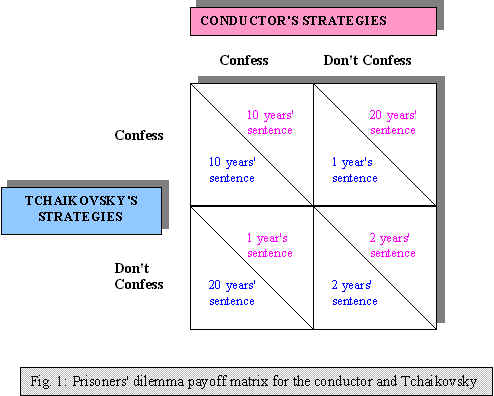
The strategies in this case are: Confess or Don't confess. The payoffs (penalties
actually!) are the sentences served. How to solve this game? What strategies are
"rational" if both men want to minimise the time they spend in jail? The
conductor might reason this way:
"Two things can happen: Tchaikovsky can confess or keep quiet. Suppose Tchaikovsky
confesses, then I'll get 20 years if I don't confess, or 10 years if I do -- so in that
case it's best to confess. On the other hand, if he doesn't confess, I'll get 2 years if I
don't either, but in that case, if I confess I'll get only a year! Either way, it's best
if I confess…"
But Tchaikovsky can, and presumably will reason in the same way -- so they both confess
and go to the prison for 10 years each. Yet, if they had acted "irrationally"
maintaining their innocence, they could have gotten off with 2 years each. In this game,
to confess is a dominant strategy and when both prisoners confess, that is the dominant
strategy equilibrium and also a Nash equilibrium (at quadrant I).
2.2 Normative Properties of Dominant
Strategy Equilibrium
The prisoners' dilemma illustrates how self-interest may lead to a world of
non-cooperation. Here we assume that there is no communication between the two
"prisoners". However, if they could communicate and commit themselves to
coordinated strategies, they are unlikely to fall into quadrant I but end up in quadrant
IV where both are better off.
If this game is played repeatedly, players are also more likely to arrive at some form
of cooperation after developing their reputations about their behaviour, and studying the
behaviour of their opponents. One strategy that worked best is "tit-for-tat",
which means that what each player should do this round depends on what the other players
did on the previous round. According to McTaggart, Findlay & Parkin (1996, p. 315), a
trigger strategy may occurs as the other extreme end of punishment indicating there are
"other intermediate degree of punishment". One example could happen if one
player cheats on one period, the other player could punish by refusing to cooperate for a
certain number of periods.
The more important feature of the DSE (or the Nash equilibrium for that matter) is that
the outcome (or payoffs) is not what the players would unanimously wish for. This
remarkable result -- that individual rational action results in both players being made
worst off in terms of their own self interested purposes -- is what has made the wide
impact in modern social and political science.
It should be noted, however, that DSE (as well as Nash equilibrium) may be unique,
exist in multiple (ie. more than one DSE), or does not exist at all.
2.3 Implications for the
Emergence of Cooperative Behaviour
We have discussed how a possible cooperation between players of a prisoners'
dilemma game will lead to a Pareto efficient outcome. But is this outcome socially
optimal? To give a better picture, let's reinterpret the above prisoners' dilemma game to
one of the business world. Assuming 2 rival airline companies -- Quantas domestic &
Ansett, fighting for a bigger market share for domestic air routes between Perth and
Melbourne or Sydney. The variables in this game is the output choice (ie. the number of
seats) manipulated by the price setting, ie., setting a higher price for the airfare
results in a lower output, and vice versa. If we represent this game in an extensive form,
we have the decision tree below:
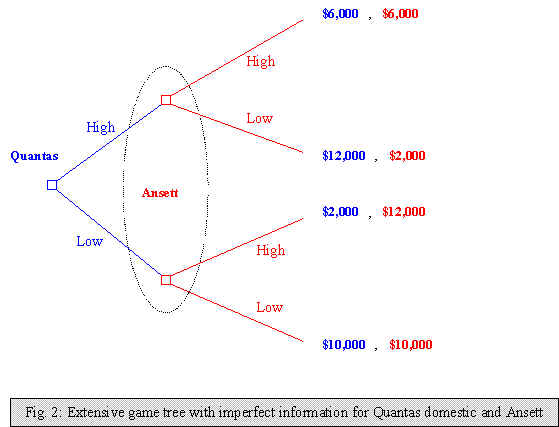
Here, we assume that both airlines have imperfect information, illustrated by Ansett
ignorance about which decision node it was in before making its move. If both airlines
were to adopt their dominant strategy, the dominant strategy equilibrium would be for both
to choose high output (competing with lower prices to undercut each other) and earn $6,000
each.
However, this DSE is Pareto inefficient, as both could be better off if they cooperate
and both produce low output (by raising their prices simultaneously) to rip off a higher
profit from consumers (making $10,000 each). Although this cartel-like behaviour could
lead to Pareto efficient outcomes for both airlines, these outcomes are not social
optimal. This is due to the fact that these firm-desired outcomes are achieved by firms
fixing prices above marginal cost and restricting output to achieve full cartel outcome,
which is not socially desirable.
It should be noted that even this price fixing practice is legal, there is an incentive
to cheat which would limit the participants from achieving the full cartel outcome.
Referring to the normal form of the above game illustrated below, either airline has the
incentive to adopt high output, and if the other remains at agreed-upon level of output
(producing low in this case). The cheating firm will earn $12,000 while the other gets
only $2,000. However if both firms cheat, the collusion will breakdown with both firms
reverting to their dominant strategy of producing high and earning $6,000 each (quadrant
I).
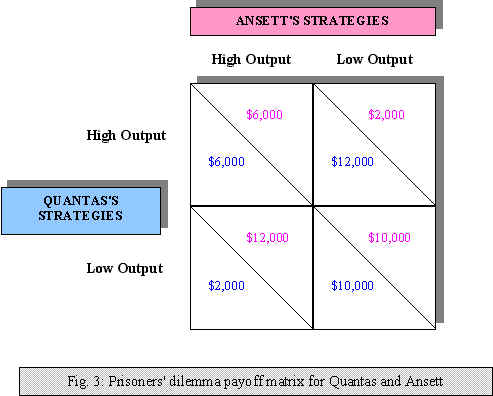
3. MAINTAINING
COLLECTIVE ACTION - A ROLE FOR
GOVERNMENT?
3.1 Problems Associated with Market Failures
As illustrated in the previous section, if firms collude and form cartels to fix price
and limit output, it is not social optimal. By doing so, Katz & Rosen (1994, p. 420)
pointed out that the necessary condition for Pareto efficiency is violated, and thus the
First Fundamental Theorem of Welfare Economics does not hold.
The First Welfare Theorem states that "a competitive economy with a market for
every commodity generates a Pareto-efficient allocation of resources without any
government intervention [emphasis added]" (Katz & Rosen 1994, p. 421). But in
reality, the required competitive environment does not always exist: monopolies, cartels,
and to a lesser extend, oligopolies and other market structures that have a certain degree
of market power can cause market failure.
The role of government to correct market failure is thus to enhance efficiency. The
government could do this by breaking monopolies and outlaw formation of cartels in order
to limit market power and restore a social optimal outcome.
In America, the Antitrust laws was enacted with the primary objective "to promote
a competitive economy by prohibiting actions that restrain, or are likely to restrain,
competition, and by restricting the forms of market structure that are allowable"
(Pindyck & Rubinfeld 1989, p. 363); while in Australia, the Trade Practices Commission
act against certain restrictive practices (such as collusive pricing and retail price
maintenance, through the Trade Practices Act, 1974) but it does not assume that market
concentration necessarily means market power and behaviour contrary to consumer interests
(Samuelson et al 1992, p. 326-27).
3.2 Problems Associated with Collective Action
On the other hand, Hardin (1971) have shown using a n-person prisoners' dilemma that
collective action of large number of players in contributing toward the purchase of
the group collective interest would fail with each player defecting from contribution and
played the dominant strategy in a "distrust" environment.
In this case, the government can play a role in ensuring all players contribute toward
the objectives by imposing "sanctions" or providing private benefits to
participating members in the form of "injunctive proscription, prescriptions, or
fines and subsidies" (Ordeshook 1986, p. 224) as proposed by Olsen (1968).
The government's environmental protection policies that imposed fine to those found
polluting the environment is one example of government's effort to maintain collective
action.
4. A BRIEF ANALYSIS INTO ARMS RACES
Anderton (1986, p. 9) defines an arms race to be "a situation where two or more
parties change the quantity or quality of their armed forces in response to perceived
past, current or anticipated future increases in the quantity or quality of armed forces
of the other party(ies)". This definition includes situations where each nation
reacts positively to the other and in particular increases its military expenditures when
the other does. According to Isard (1988), each may do so in order to:
- reduce insecurity (reflecting a balance of power motivation);
- retaliate for the insecurity caused by the other's increased military expenditures and
military activities (reflecting a balance of terror motivation);
- counteract the ambition of the other; and/or
- be in a position of greater strength when negotiations on arms control are expected in
the future.
In our analysis, we shall focus on the recent stand-off between the Indian and Pakistan
government caused by their nuclear testing programmes.
4.1 Modelling
the Nuclear Arms Race in the Indian sub-continent
India has fought three wars with Pakistan since 1947 and suffered a crushing defeat at
the hands of China in a 1962 border conflict. The following year, it denied an allegation
by the U.S. that it produces an atomic bomb to counter China, which was expected to become
a nuclear power. It was only after Pakistan's commenced its alleged clandestine nuclear
weapons program in 1972 that India took the unavoidable counter-measure of
conducting its first nuclear test in Pokhran, in 1974 (Kapur & Wilson 1996; Moshaver
1991).
Before those developments, the dilemma then facing both would-be nuclear nations were
whether to engage in the development of nuclear weapons or not: a classic gun verses
butter issue.
We can model this vaguely in a prisoners' dilemma payoff matrix overleaf:
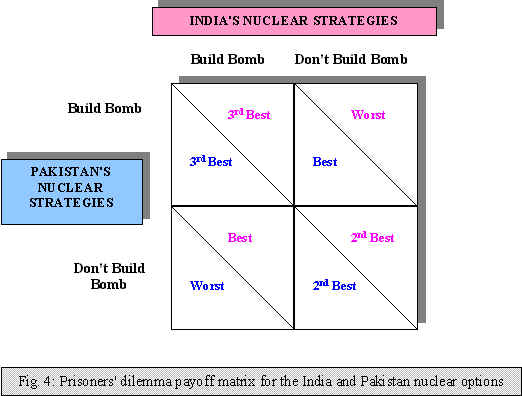
Here, both nations identified the advantage of possessing nuclear weapons if the other
does not. Both nations, being non-signatories of the nuclear Non-Proliferation or other
related treaty, cannot rely on each other's assurance to stay in quadrant IV, where both
"don't build bomb" and concentrate on their economic development, deemed second
best option for both. Consequently, they ended up in the DSE.
"If India openly starts a weapons programme, the deep-rooted Pakistani fears of
India…would put tremendous pressure on Pakistan to take appropriate measures to avoid
a nuclear Munich at India's hands in the event of an actual conflict, which many
Pakistanis think very real."
Senior Pakistani nuclear scientist,
Abdul Qadir Khan, Fall 1985
"If Pakistan gets a nuclear weapon, India will have to think very seriously about
its own option. …We have every indication and information that leads us to believe
that Pakistan has not given up its nuclear weapons program and is bent on having it."
The late Indian Prime Minister,
Rajiv Gandhi, April 1986
The second Indian nuclear test of 5 atomic devices 24 years later on the 11 and 13 May
1998 came after the fact that Pakistan has not only acquired nuclear weapons and missile
capability, but also her Prime Minister threatened their use against India (Asiaweek
1998).
Then came the dramatic announcement of Pakistan's first-ever nuclear tests on 29 May
followed by another one the following day bringing a total of six devices exploded. This
matches India's total since 1974.
''Today we have successfully carried out five tests...we have evened the account
with India"
''We did not force Pakistan into this. In fact, it is Pakistan's clandestine
preparations forced us to the path of nuclear deterrence"
Indian Prime Minister
Atal Bihari Vajpayee, 29 May 1998
The 6 nuclear devices detonated by Pakistan portrayed Pakistan's desire to match
India's nuclear capabilities at least in quantity. If we assume that India wanted to lead
Pakistan in terms of the number of nuclear arsenal by, say 10% as her national security
policy, we can represent the dynamics of this nuclear weapons build-up in the diagram
below:
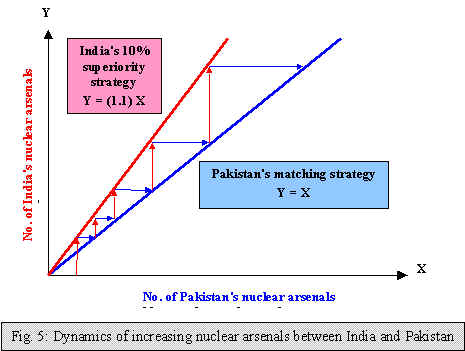
The vertical red arrows show India's increment of its nuclear weapons to keep up her
national security policy of 10% superiority over her rival; while the horizontal blue
arrows show Pakistan's desire to match India's number every round. This can leads to an
endless arms race.
"As a responsible nation, whose record of restraint and responsibility is
impeccable, Pakistan today assures the international community and, in particular, India,
of our willingness to enter into immediate discussions to address all matters of peace and
security, including urgent measures to prevent the dangers of nuclear conflagration"
Pakistani Foreign Secretary,
Shamshad Ahmad, 30 May 1998
With the latest indication by India and Pakistan to go to the negotiation table, we
would expect to see some form of arms control. Again, we can model this situation below:
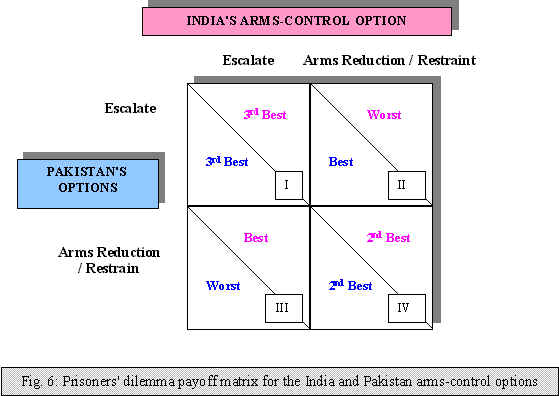
If both nations can work together closely to abide by the arms control agreement
(without attempting to cheat), we can expect to see a peaceful solution to the tension in
the Indian subcontinent with both India and Pakistan refraining from escalating the
nuclear arms race.
Although game theory can be (and have been) used to analyse political and military
events, they have been criticised as a dehumanising and potentially dangerous
oversimplification of necessarily complicating factors (Dauben 1996) which would lead to
deficiency in their analysis.
No. of words: 2496 (Contents Only)
5. LIST OF REFERENCE
Anderton, Charles H. (1986) 'Arms Race Modelling: Systematic Analysis and Synthesis',
Ph.D. dissertion, Cornell University.
Asiaweek (1998) 'Why India's Bomb is Justified' Asiaweek Online, Accessed on 24
May 1998 at [http://www.pathfinder.com/asiaweek/current/issue/nat3.html]
Axelod, Robert (1984) The Evolution of Cooperation, Basic Books, New York.
Danben, Joseph Warrant (1996) 'Game Theory', in Microsoft ® Encarta ® 97
Encyclopedia, Microsoft Corporation.
Hagenmayer, J., and Glazer, A. (1992) 'Albert W. Tucker, 89, Framed Mathematician', Philadelphia
Inquirer, 2 Feb, p. B7.
Hardin, R. (1971) "Collective Action as an Agreeable n-Person Prisoners' Dilemma',
Behavioural Science, 16. p. 472-81.
Isard, Walter (1988) Arms Races, Arms Control, and Conflict Analysis, Cambridge
University Press, New York.
Kapur, Ashok (1996) Foreign Policies of India and her Neighbours, St. Martin's
Press, Inc., New York.
Katz, Michael L. and Rosen, Harvey S. (1994) Microeconomics, 2nd Ed.,
Richard D. Irwin, Inc., Illinois.
McTaggart, D., Findlay, C., and Parkin, M (1996) Microeconomics, 2nd
Ed., Addison-Westley Publishing Co., Sydney.
Moshaver, Ziba (1991) Nuclear Weapons Proliferation in the Indian Subcontinent,
MacMillian Academic and Professional Ltd., Hampshire
Olsen, M. (1968) the Logic of Collective Action, Harvard University Press.
Ordeshook, P.C. (1986) Game Theory and Political Theory: An Introduction,
Cambridge University Press.
Pindyck, R.S., and Rubinfeld, D.L. (1992) 'Market Power: Monopoly and Monopsony' in Microeconomics,
2nd Ed., MacMillian Publishing Co., New York.
APPENDICES (News Coverage on
India & Pakistan's Nuclear Tests)
Sources :
- Straits Times Interactive [http://www.asia1.com.sg/straitstimes/]
- The Times of India Online [http://www.timesofindia.com/today/]
- The News Pakistan [http://www.jang-group.com/thenews]
- Asiaweek Online ;www.pathfinder.com/asiaweek/current/issue]
Return to Assignments for Semester 1, 1998





